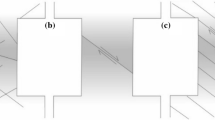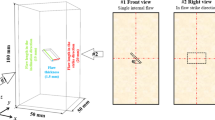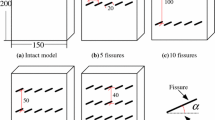Abstract
In mining engineering, the grade of the orebody significantly influences mining activities. Typically, the grade of completed mine sequences can be used to estimate the yearly mine’s production and profit. However, the strength of orebody varies in different parts of the mine, as demonstrated by the requirement for different blast design. The degree of rock fragmentation cannot be accurately predicted after production blasts; in addition, secondary breakage of oversized rock affects the mining plan. In this study, split Hopkinson pressure bar tests were conducted to obtain the dynamic tensile strength and fracture energy of orebody rock having different grades. The fracture surfaces were obtained using a 3D scanner and surface roughness was estimated on the basis of fractal dimensions. The failure process of ore rock was reproduced through the flat-joint model (FJM) in PFC2D on the basis of microscopic and macroscopic images of the fracture surface using a special FJM structure. Physical experiments and numerical simulations indicated that the mechanical properties and fracture characteristics of the orebody rock vary with its grade. This difference should be considered during mining activities, specifically in blast and draw point designs.
























Similar content being viewed by others
Abbreviations
- \(\varepsilon_{{\text{i}}}\) :
-
Incident wave
- \(\varepsilon_{{\text{r}}}\) :
-
Reflected wave
- \(\varepsilon_{{\text{t}}}\) :
-
Transmitted wave
- \(P_{1}\), \(P_{2}\) :
-
Forces at the two bar/specimen interfaces
- A :
-
Bars’ cross-sectional area
- E :
-
Bars’ Young’s modulus
- \(P\left( t \right)\) :
-
The mean force applied to the specimen
- \(\sigma_{{{\text{ten}}}} \left( t \right)\) :
-
The tensile stress at the sample center
- d :
-
Diameter of the disk
- t :
-
Thickness of the disk
- \(W_{{\text{i}}}\) :
-
Energy of the incident stress wave
- \(W_{{\text{r}}}\) :
-
Energy of the reflected stress wave
- \(W_{{\text{t}}}\) :
-
Energy of the transmitted stress wave
- C :
-
Wave velocity of the bars
- \(W_{{\text{l}}}\) :
-
Energy absorbed by a rock specimen
- \(W_{{{\text{fd}}}}\) :
-
Fracture and damage energy of the rock specimen
- \(W_{{\text{k}}}\) :
-
Kinetic energy of flying fragments
- \(W_{{\text{o}}}\) :
-
Other energy
- \(v_{1}\), \(v_{2}\) :
-
Flying speed of two fragments
- m :
-
Mass of the intact disk
- D :
-
Fractal dimension
- \(\sigma_{{\max}}^{{\left( {\text{e}} \right)}}\) :
-
The maximum normal stress
- \(\tau_{{\max}}^{{\left( {\text{e}} \right)}}\) :
-
The maximum shear stress
- \(F_{{\text{n}}}^{{\left( {\text{e}} \right)}}\) :
-
Normal forces acting at the element
- \(F_{{\text{s}}}^{{\left( {\text{e}} \right)}}\) :
-
Shear forces acting at the element
- \(A^{{\left( {\text{e}} \right)}}\) :
-
Area of the element
- \(\varphi_{{\text{b}}}\) :
-
Fractions of bonded contacts
- \(\varphi_{{\text{g}}}\) :
-
Fractions of gapped contacts
- \(\varphi_{{\text{s}}}\) :
-
Fractions of slit contacts
- \(E_{{{\text{st}}}}\) :
-
Strain energy
- \(E_{{{\text{sl}}}}\) :
-
Slip energy
- E r :
-
Young’s modulus of rock
- μ :
-
Poisson’s ratio of rock
- \(F_{{\text{i}}}^{^{\prime}} \left( t \right)\) :
-
The force in the incident bar model
- \(F_{t}^{^{\prime}} \left( t \right)\) :
-
The force in the transmitted bar model
- \(\sigma_{{\text{i}}}^{^{\prime}} \left( t \right)\) :
-
The stress in the incident bar model
- \(\sigma_{{\text{t}}}^{^{\prime}} \left( t \right)\) :
-
The stress in the transmitted bar model
- \(\sigma_{{{\text{ten}}}}^{^{\prime}} \left( t \right)\) :
-
Tensile stress in the PFC2D model
- \(F_{{\text{i}}} \left( t \right)\) :
-
The force in the incident bar
- \(\sigma_{{\text{i}}} \left( t \right)\) :
-
The stress in the incident bar
- FJM:
-
Flat-joint model
- SHPB:
-
Split Hopkinson pressure bar
- DIC:
-
Digital image correlation
- XRD:
-
X-ray diffraction
- COD:
-
Crack-opening displacement
- AOI:
-
Area of interest
- PFC:
-
Particle flow code
- SEM:
-
Scanning electron microscope
- UCS/TS:
-
Unconfined compressive-strength-to-tensile-strength ratio
- PBM:
-
Parallel bond model
- BTS:
-
Brazilian tensile strength
References
Ai T, Zhang R, Zhou HW, Pei JL (2014) Box-counting methods to directly estimate the fractal dimension of a rock surface. Appl Surf Sci 314(10):610–621
Banadaki MMD (2010) Stress-wave induced fracture in rock due to explosive action. University of Toronto, Toronto
Bertholf LD, Karnes CH (1975) Two-dimensional analysis of the split Hopkinson pressure bar system. J Mech Phys Solids 23(1):1–19
Chen R, Xia K, Dai F, Lu F, Luo SN (2009) Determination of dynamic fracture parameters using a semi-circular bend technique in split Hopkinson pressure bar testing. Eng Fract Mech 76(9):1268–1276
Chen R, Dai F, Qin J, Lu F (2013) Flattened Brazilian disc method for determining the dynamic tensile stress-strain curve of low strength brittle solids. Exp Mech 53(7):1153–1159
Cotsovos DM, Pavlovic MN (2008) Numerical investigation of concrete subjected to compressive impact loading. Part 2: parametric investigation of factors affecting behaviour at high loading rates. Comput Struct 86(1–2):164–180
Cundall PA, Strack ODL (1979) A discrete numerical model for granular assemblies. Geotechnique 29:47–65
Dai F, Chen R, Iqbal MJ, Xia K (2010) Dynamic cracked chevron notched Brazilian disc method for measuring rock fracture parameters. Int J Rock Mech Min Sci 47:606–613
Dai F, Xia K, Zheng H, Wang YX (2011) Determination of dynamic rock mode-I fracture parameters using cracked chevron notched semi-circular bend specimen. Eng Fract Mech 78:2633–2644
Demirdag S, Tufekci K, Kayacan R, Yavuz H, Altindag R (2010) Dynamic mechanical behavior of some carbonate rocks. Int J Rock Mech Min Sci 47:307–312
Ding X, Zhang L (2014) A new contact model to improve the simulated ratio of unconfined compressive strength to tensile strength in bonded particle models. Int J Rock Mech Min Sci 69:111–119
Fakhimi A, Lanari M (2014) DEM–SPH simulation of rock blasting. Comput Geotech 55:158–164
Fonseka GM, Murrell SAF, Barnes P (1985) Scanning electron microscope and acoustic emission studies of crack development in rocks. Int J Rock Mech Min Sci Geomech Abstr 22(5):273–289
Forquin P (2012) An optical correlation technique for characterizing the crack velocity in concrete. Eur Phys J Spec Top 206:89–95
Gao G, Huang S, Xia K, Li Z (2015) Application of digital image correlation (DIC) in dynamic notched semi-circular bend (NSCB) tests. Exp Mech 55:95–104
Hamdi P, Stead D, Elmo D (2015) Characterizing the influence of stress-induced microcracks on the laboratory strength and fracture development in brittle rocks using a finite-discrete element method-micro discrete fracture network FDEM-μDFN approach. J Rock Mech Geotech Eng 7(6):609–625
Hamdi P, Stead D, Elmo D, Töyrä J (2018) Use of an integrated finite/discrete element method-discrete fracture network approach to characterize surface subsidence associated with sub-level caving. Int J Rock Mech Min Sci 103:55–67
Hu G, Ramesh KT, Cao B, McCauley JW (2011) The compressive failure of aluminium nitride considered as a model advanced ceramic. J Mech Phys Solids 59:1076–1093
Huang S, Xia KW (2015) Effect of heat-treatment on the dynamic compressive strength of Longyou sandstone. Eng Geol 191:1–7
Itasca Consulting Group, Inc. (2015) PFC—particle flow code in 2 and 3 dimensions, version 5.0, Documentation Set of version 5.00.21. Minneapolis. Itasca.
Jin AB, Sun H, Ma GW, Gao YT, Wu SC, Meng XQ (2016) A study on the draw laws of caved ore and rock using the discrete element method. Comput Geotech 80:59–70
Kumar A (1968) The effect of stress rate and temperature on the strength of basalt and granite. Geophysics 33:501–510
Li QM, Meng H (2003) About the dynamic strength enhancement of concrete-like materials in a split Hopkinson pressure bar test. Int J Solids Struct 40(2):343–360
Li XB, Lok TS, Zhao J, Zhao PJ (2000) Oscillation elimination in the Hopkinson bar apparatus and resultant complete dynamic stress-strain curves for rocks. Int J Rock Mech Min Sci 37:1055–1060
Li XB, Lok TS, Zhao J (2005) Dynamic characteristics of granite subjected to intermediate loading rate. Rock Mech Rock Eng 38:21–39
Li XB, Zhou ZL, Lok TS, Hong L, Yin TB (2008) Innovative testing technique of rock subjected to coupled static and dynamic loads. Int J Rock Mech Min Sci 45:739–748
Li XB, Zou Y, Zhou ZL (2014) Numerical simulation of the rock SHPB test with a special shape striker based on the discrete element method. Rock Mech Rock Eng 47(5):1693–1709
Liu CP, Duan QQ (2009) Meso-structure analysis on instability of dynamic fracture in rock. In: Fourth international conference on experimental mechanics, Singapore, vol 1. SPIE, p 752210
Lu YB, Li QM, Ma GW (2010) Numerical investigation of the dynamic compressive strength of rocks based on split Hopkinson pressure bar tests. Int J Rock Mech Min Sci 47(5):829–838
Ma GW, An XM (2008) Numerical simulation of blasting-induced rock fractures. Int J Rock Mech Min Sci 45(6):966–975
Nath F, Mokhtari M (2018) Optical visualization of strain development and fracture propagation in laminated rocks. J Petrol Sci Eng 167:354–365
Park SW, Xia Q, Zhou M (2001) Dynamic behavior of concrete at high strain rates and pressures: II. Numerical simulation. Int J Impact Eng 25(9):887–910
Potyondy D (2011) Parallel-bond refinements to match macroproperties of hard rock. In: Proceedings of the second international FLAC/DEM symposium, Melbourne, Itasca, pp 459–465
Potyondy D (2012) PFC2D flat-joint contact model. Itasca Consulting Group Inc, Minneapolis Potyondy DO (2013) PFC3D flat joint contact model version 1. Itasca Consulting Group[R]. Minneapolis, Technical Memorandum ICG7234-L
Potyondy D, Cundall PA (2004) A bonded-particle model for rock. Int J Rock Mech Min Sci 41(8):1329–1364
Saharan MR, Mitri HS (2008) Numerical procedure for dynamic simulation of discrete fractures due to blasting. Rock Mech Rock Eng 41(5):641–670
Shim HJ, Ryu DW, Chung SK, Synn JH, Song JJ (2009) Optimized blasting design for large-scale quarrying based on a 3-D spatial distribution of rock factor. Int J Rock Mech Min Sci 46(2):326–332
Silva BGD, Einstein HH (2018) Physical processes involved in the laboratory hydraulic fracturing of granite: visual observations and interpretation. Eng Fract Mech 191:125–142
Sun C (2013) Damage zone prediction for rock blasting. Department of Mining Engineering, University of Utah, Salt Lake City
Tedesco JW, Ross CA (1998) Strain-rate-dependent constitutive equations for concrete. ASME J Press Vessel Technol 120:398–405
Wang P, Xu JY, Liu S, Wang HY, Liu SH (2016) Static and dynamic mechanical properties of sedimentary rock after freeze-thaw or thermal shock weathering. Eng Geol 210:148–157
Wei XY, Zhao ZY, Gu J (2009) Numerical simulations of rock mass damage induced by underground explosion. Int J Rock Mech Min Sci 46(7):1206–1213
Wong LNY, Einstein HH (2009) Crack coalescence in molded gypsum and carrara marble: part 2-microscopic observations and interpretation. Rock Mech Rock Eng 42:513–545
Wu SC, Xu XL (2015) A study of three intrinsic problems of the classic discrete element method using flat-joint model. Rock Mech Rock Eng 49(5):1813–1830
Wu W, Zhu JB, Zhao J (2013) Dynamic response of a rock fracture filled with viscoelastic materials. Eng Geol 160:1–7
Xia K, Nasseri MHB, Mohanty B, Lu F, Chen R, Luo SN (2008) Effects of microstructures on dynamic compression of Barre granite. Int J Rock Mech Min Sci 45(6):879–887
Xie H, Wang JA, Stein E (1998) Direct fractal measurement and multifractal properties of fracture surfaces. Phys Lett A 242:41–50
Xie H, Wang JA, Kwaśniewski MA (1999) Multifractal characterization of rock fracture surfaces. Int J Rock Mech Min Sci 36:19–27
Xing HZ, Zhang QB, Ruan D, Dehkhoda S, Lu GX, Zhao J (2018a) Full-field measurement and fracture characterisations of rocks under dynamic loads using high-speed three-dimensional digital image correlation. Int J Impact Eng 113:61–72
Xing HZ, Zhang QB, Zhao J (2018b) Stress thresholds of crack development and Poisson’s ratio of rock material at high strain rate. Rock Mech Rock Eng 51:945–951
Xu Y, Dai F, Xu NW, Zhao T (2016) Numerical investigation of dynamic rock fracture toughness determination using a semi-circular bend specimen in split Hopkinson pressure bar testing. Rock Mech Rock Eng 49(3):731–745
Yang JH, Lu WB, Hu YG, Chen M, Yan P (2015) Numerical simulation of rock mass damage evolution during deep-buried tunnel excavation by drill and blast. Rock Mech Rock Eng 48:2045–2059
Zhang ZX (2016) Rock fracture and blasting: theory and applications. Butterworth-Heinemann, Oxford
Zhang XP, Wong LNY (2012) Cracking processes in rock-like material containing a single flaw under uniaxial compression: a numerical study based on parallel bonded-particle model approach. Rock Mech Rock Eng 45(5):711–737
Zhang QB, Zhao J (2013a) Determination of mechanical properties and full-field strain measurements of rock material under dynamic loads. Int J Rock Mech Min Sci 60:423–439
Zhang QB, Zhao J (2013b) Effect of loading rate on fracture toughness and failure micromechanisms in marble. Eng Fract Mech 102:288–309
Zhang QB, Zhao J (2014a) A review of dynamic experimental techniques and mechanical behaviour of rock materials. Rock Mech Rock Eng 47:1411–1478
Zhang QB, Zhao J (2014b) Quasi-static and dynamic fracture behaviour of rock materials: phenomena and mechanisms. Int J Fract 189:1–32
Zhang ZX, Kou SQ, Jiang LG, Lindqvist PA (2000) Effects of loading rate on rock fracture: fracture characteristics and energy partitioning. Int J Rock Mech Min Sci 37:745–762
Zhao J, Zhou YX, Hefny AM, Cai JG, Chen SG, Li HB, Liu JF, Jain M, Foo ST, Seah CC (1999) Rock dynamics research related to cavern development for ammunition storage. Tunn Undergr Sp Tech 14:513–526
Zhao Y, Zhao GF, Jiang Y (2013) Experimental and numerical modelling investigation on fracturing in coal under impact loads. Int J Fract 183(1):63–80
Zhou HW, Xie H (2003) Direct estimation of the fractal dimensions of a fracture surface of rock. Surf Rev Lett 10:751–762
Zhou YX, Xia K, Li XB, Li HB, Ma GW, Zhao J, Zhou ZL, Dai F (2012) Suggested methods for determining the dynamic strength parameters and mode-I fracture toughness of rock materials. Int J Rock Mech Min Sci 49:105–112
Zhou ZL, Cai X, Chen L, Cao WZ, Zhao Y, Xiong C (2017) Influence of cyclic wetting and drying on physical and dynamic compressive properties of sandstone. Eng Geol 220:1–12
Zhu WC, Bai Y, Li XB, Niu LL (2012) Numerical simulation on rock failure under combined static and dynamic loading during SHPB tests. Int J Impact Eng 49:142–157
Zou CJ, Wong LNY, Loo JJ, Gan BS (2016) Different mechanical and cracking behaviors of single-flawed brittle gypsum specimens under dynamic and quasi-static loadings. Eng Geol 201:71–84
Acknowledgements
This work was supported by the National Natural Science Foundation of China (No. 51674015).
Author information
Authors and Affiliations
Corresponding author
Ethics declarations
Conflict of interest
The authors declare that they have no conflicts of interest. We declare that we do not have any commercial or associative interest that represents a conflict of interest in connection with the work submitted.
Additional information
Publisher's Note
Springer Nature remains neutral with regard to jurisdictional claims in published maps and institutional affiliations.
Rights and permissions
About this article
Cite this article
Liu, B., Gao, YT., Jin, AB. et al. Fracture Characteristics of Orebody Rock with Varied Grade Under Dynamic Brazilian Tests. Rock Mech Rock Eng 53, 2381–2398 (2020). https://doi.org/10.1007/s00603-020-02048-9
Received:
Accepted:
Published:
Issue Date:
DOI: https://doi.org/10.1007/s00603-020-02048-9




